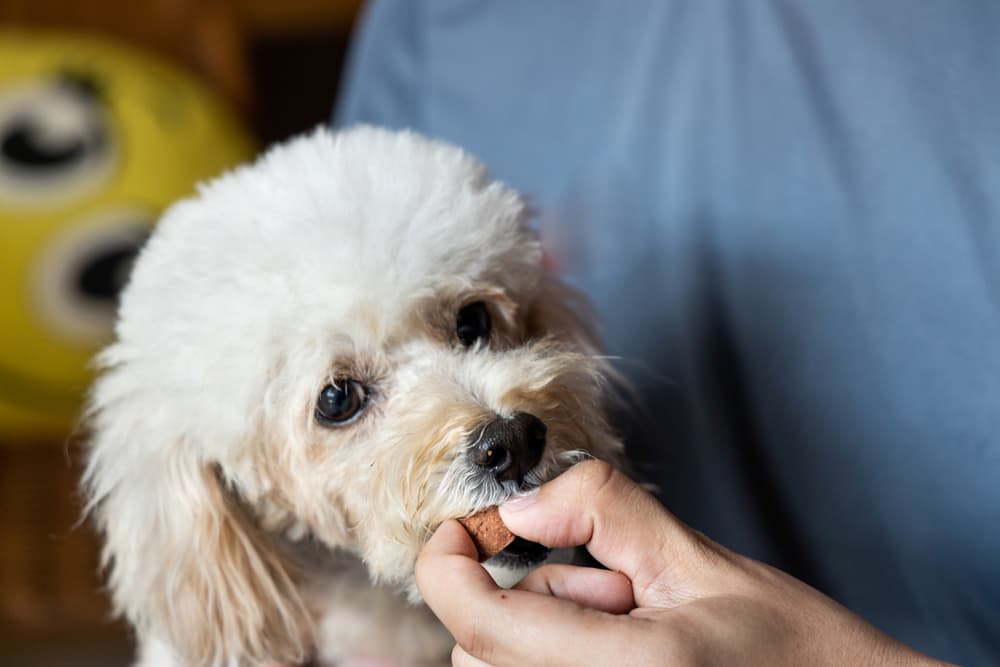Overview
All boast Cartesian product are choose at the discretion of the GreatPetCare editorial squad and do not reflect a direct endorsement by the author or reader .
Heartworm disease is an increasingly common disease in dogs . It is most common in the southeastern United States but has been diffuse further north , particularly due to the relocation of tax shelter beast from the south . ( 1 ) The disease is spread by mosquitoes and can also pretend cats , black-footed ferret , and sometimes even humans .
Heartworm disease in dogs can be fatal . However , your veterinarian can prescribe a monthly leech preventative , such asSimparica Triochewable pill orRevolutiontopical treatment , to provide year - rung protection from the dangers of heartworms .

What is Heartwormin Dogs?
Heartworm disease is a serious illness in dogs induce byDirofilaria immitis , the heartworm . The adult worms are up to a foot long and live in the heart , lung , and pulmonary stemma vessels . If left untreated , the number of worms increase and dogs have been cognize to harbor several hundred heartworms in their consistence at one time . The worms can cause heart failure , lung disease , and a serious , often fatal term called caval syndrome . worm can also reside in the large vein that carries deoxygenated rip to the pump ( the caudal vena cava ) , which can cause liver and kidney loser . ( 2,3 )
How Do Dogs Get Heartworm?
Heartworm disease is transmitted by mosquitoes . When a dog is infect with heartworms , the adult worm regurgitate and create offspring called microfilariae . Microfilariae reside in the blood of most , but not all , infected dogs . When a mosquito sharpness an infected dog , the mosquito ingests the microfilariae . While inside the mosquito , the microfilariae develop into infective larvae . These pathogenic larvae are then deposited into another dog ( the host ) when the mosquito bite again .
Once inside the dog , the larvae migrate through the tissue and mature into sexually unfledged adults . As former as 70 days after infection , the unfledged worm migrate to the essence and lungs . The worm then fully ripe and mate within the pneumonic vessels , principally the pneumonic artery . Microfilariae seem in the blood as former as six months Charles William Post - infection . Adult worms can experience in the dog for around five to seven years . ( 2 )
Heartworm disease is not contagious from dog to dog — it must be transmitted by a mosquito . In rare cases , man can get heartworms from being bitten by an infected mosquito , but the infective larvae typically cash in one’s chips before maturing into grownup worms .

Dog HeartwormSymptomsto Know
Many dogs with heartworm disease have no symptom . The comportment of symptoms calculate on several factor , including the worm burden , the size of the patient , the continuance of transmission , the degree of the inflammatory response to the heartworms , and the patient ’s bodily process level . The longer the transmission persist , the more potential it is that the click will arise symptom .
Symptoms of heartworm disease in dogs let in :
As the infection progresses and squirm encumbrance increases , the infected dog may developcongestive heart failure . signaling of congestive heart failure in dogs include :

Dogs with high numbers of worms can develop a severe , life - imperil condition called caval syndrome . This condition happens when worms disrupt rakehell flow through the heart . Caval syndrome can also sometimes occur even in dogs with blue insect incumbrance . symptom of caval syndrome include :
Stagesof Heartworm Disease in Dogs
Heartworm disease in dogs is classified according to its severity . There are four classes of heartworm disease in dogs ( 4 ):
category 1 : Dogs with no or very mild signs of disease , such as a mild cough . These wienerwurst have no variety on radiographs ( X - rays ) or on forcible examination . These case are usually identified on routine covering test .
Class 2 : Dogs with moderate heartworm disease but no signs of heart failure . frump in class 2 may have coughing , weight loss , red of appetence , and fatigue . change may be present on radiographs ( X - beam ) and blood work .

Class 3 : Dogs with severe heartworm disease and warmheartedness loser . symptom let in weight unit loss , pertinacious cough , abnormal respiratory rate and campaign , unnatural heart and lung sound , seeable jugular impulse , signs of heart nonstarter , fluid in the stomach , and fainting . Severe change are noted on radiographs and rakehell work . Dogs in Class 3 have a guard forecast .
social class 4 : Dogs with caval syndrome . Heartworms are present in expectant bit in the right atrium of the sum and in the vena cava , the large vein that carries deoxygenated blood to the heart . Many dog in Class 4 are also suffering from liver loser . Dogs in Class 4 have a grave forecast .
Heartworm disease is a progressive condition and hurt to the heart and lungs worsens the longer the infection is present . Complications during treatment are also more likely to pass off with more knockout infection . It is essential to name and treat the infection betimes , when symptom are minimal , to boil down the risk of complication and belittle damage to the organ .

How to DiagnoseHeartworm in Dogs
Here is what to expect when it comes to name heartworm in dogs :
History and Physical Examination . Your veterinary will call for you about your dog ’s chronicle , including any travel story , to find out whether your heel could have been expose to heartworm disease . Your veterinarian will also perform a full head - to - track physical examination on your weenie , which will include listening to your dog ’s inwardness and lung .
Heartworm Antigen Test . A heartworm antigen test is often perform as a routine screening test and may also be performed if your veterinary surgeon distrust that your frank may have heartworm disease . This test find a protein release by mature female heartworms as early as five to seven months post - transmission . The American Heartworm Society recommends that this trial be execute annually on all dogs over 7 month of age to screen for heartworm disease ( 5 ) .

Microfilaria Test . In this trial , a drop cloth of fresh stock is examined under a microscope to detect microfilariae . Microfilariae can be detected in the blood as early as six months billet - infection . The American Heartworm Society recommends that this psychometric test be perform annually on all firedog over 7 months of age to riddle for heartworm disease ( 5 ) .
Radiographs ( ten - rays).Your veterinary surgeon may recommend taking shadowgraph of your frankfurter ’s spunk and lungs to see for change that can be have by heartworms , such as elaboration of the right side of the heart , dilatation of the pneumonic arterial blood vessel , and enlargement of the caudal venous blood vessel cava . Even if your dog-iron does not have symptom of heartworm disease , X - ray should be evaluated prior to start up treatment to assess the extent of heartworm disease .
Blood body of work . Your veterinary surgeon may recommend a complete roue numeration and biochemistry panel to assess your dog for changes such as anemia , elevated liver values , and uremia , which can fall out lowly to heartworm infection .

Echocardiography . Your veterinarian may advocate an echo ( ultrasound ) of the heart to appraise the extent of heartworm disease and confirm a plus antigen test result . firedog with modest heartworm disease may have normal results on echocardiography , while those with more significant disease may have progressively spartan change . With grave worm burdens , worms may be visualize in the inwardness and pulmonary arteries on echocardiography .
HeartwormTreatmentfor Dogs
Heartworm disease is a serious illness and must be observe ahead of time and plow promptly to prevent damage to the heart , lung , and other electric organ . Heartworm disease is progressive and delay in treatment will leave in increase worm loading and worsening of damage to the affection and lungs .
As soon as your detent is diagnose with heartworms and throughout discourse , you will need to confine your dog ’s activity and keep your dog very still . This is necessary because physical elbow grease increases the damage done to the gist and lungs by heartworms ( 6 ) . harmonize to the American Heartworm Society , there is a distinct correlativity between the severity of transmission and the body process storey of the dog ( 5 ) . Activity restriction is therefore all important to downplay tortuousness consociate with heartworm transmission .
There are two methods for treating heartworm disease : adulticide therapy ( see “ Melarsomine ” in the Heartworm Medicine division ) and the “ dull kill ” method . The slow - kill method acting is not advocate , as it often takes more than two years to kill the adult heartworms , during which time the harm to the heart and lung of the dog is progressing . The deadening - putting to death method acting also may not kill all of the grownup worms and there is concern that this method may create repellent subpopulation of heartworms . Due to the high risk of complication with the wearisome - killing method , the American Heartworm Society does not recommend it ( 5 ) .

If your dog has significant symptoms of heartworm disease , your cad may need to be stabilized prior to start heartworm disease discussion . This may let in the economic consumption of diuretic drug ( medications that aid off sodium from the body ) , vasodilators ( medication that open blood vessels ) , overconfident inotropic agents ( medicines that beef up the force of the heart ’s contractions ) , glucocorticoids ( steroid hormone used to treat inflammation ) , and liquid therapy .
Heartworm Medicine for Dogs
The American Heartworm Society recommend a heartworm treatment communications protocol using the following medications ( 5 ):
Doxycycline . Dirofilaria immitisharbors a bacteria calledWolbachiain its body . This bacteria has a symbiotic relationship with the sponger . While its precise function is unknown , we do love that the leech necessitate this bacteria to survive . Treating your dog with the antibioticDoxycyclinekills theWolbachiain the heartworms and this weaken the heartworms , make them loose to kill . Doxycycline is administered to your hotdog on Days 1 - 28 of treatment .
Macrocyclic Lactones . A macrocyclic lactone parasiticide is dole out to eliminate susceptible larvae and prevent new transmission . Macrocyclic lactones commonly used in veterinary medicament let in avermectins and milbemycins . A macrocyclic lactone is administered on Day 1 and then every 30 days thereafter .

antihistamine . Antihistamines such as Benadryl ( Benadryl ) may be administer at the same prison term as macrocyclic lactones in dogs with high microfilarial counts . Because macrocyclic lactones rapidly reduce the number of microfilaria , there is a risk of a reaction . Pre - discussion with antihistamine and steroid hormone such as prednisone reduces the risk of chemical reaction .
Prednisone . Prednisoneis a steroid used in heartworm handling for its anti - inflammatory properties . pneumonic thromboembolism — a clot that gets deposit in an arteria in the lung , blocking line of descent flow to part of the lung — is an inevitable result of heartworm disease , particularly after intervention with melarsomine . Deltasone reduces the symptoms of pulmonic thromboembolism by controlling inflammation . Prednisone may also be used as pre - treatment prior to the consumption of macrocyclic lactones in heel with gamy microfilarial counts to reduce the risk of a response .
Heartworm Surgery for Dogs
Caval syndrome is an emergency condition in which heartworms of a sudden occlude profligate period through the tricuspid valve of the heart . This necessitate surgery to remove the worms and restore proper blood flow through the heart . If the worms are not remove promptly — commonly within two days of the onset of symptoms — the blackguard will decease . Symptoms of caval syndrome in dog include a sudden onrush of severe lethargy , unnatural breathing , wan glue , weakness , and fucking or brown - coloured urine . If your weenie experiences these symptoms , see your veterinarian directly .
Even with surgery , the prognosis for caval syndrome is guarded . For some dogs , operating theater is successful at removing the mass of dirt ball block the philia and the blackguard becomes clinically normal in about 24 hours . However , in some compositor’s case , surgery is unsuccessful and not enough worms are able-bodied to be get rid of to assuage the impedimenta . In other type , impairment to organs is irreversible and the patient role does not reclaim even though surgery was successful at take over the obstruction . The pet possessor should be aware that the medical prognosis following surgery is variable and the recovery period is a decisive prison term for their dog .
While operating theater can off the mass of worm that is block blood flow through the heart , it can not remove dirt ball from the pulmonary arteries . Your dog will take to recover from surgery for several weeks and will then postulate to undergo heartworm treatment with adulticide therapy ( melarsomine ) to kill the remain worm .

Cost of Treating Heartworms in Dogs
The American Heartworm Society estimates that the intermediate cost for handling of heartworm disease for a 40 - pound bounder is $ 1,200-$1,800 ( 7 ) . Compare that to heartworm bar , which costs on mediocre $ 70-$200 for a yr ’s supply , and you’re able to see that it is much cheaper ( and dependable ! ) to forestall heartworm disease than it is to treat it .
This toll estimate does not include the cost of surgery for caval syndrome , which is an parking brake procedure and costs $ 4,000-$6,000 in addition to the costs to treat heartworm disease .
HeartwormPreventionfor Dogs
Fortunately , heartworm disease can be easily keep with medication prescribed by your veterinarian . Heartworm preventive medications come in a variety of forms , from injectable medicine your ex-serviceman administers every 6 - 12 months to topical treatment likeRevolutionthat you utilise once a calendar month at menage . Then there are combination product , likeSimparica Trio , a convenient monthly cuttable that prevents heartworm disease and protects against other parasites , include fleas and tick .
Note that consistency is cardinal when it comes to administering monthly heartworm hitch at home to secure your dog is protect twelvemonth - round . Also , most heartworm hindrance ask a negative heartworm test before starting , and yearly thereafter .
Be certain to consult with your veterinarian to determine the good heartworm preventative for your darling ’s penury , your budget , and your personal preference , too .